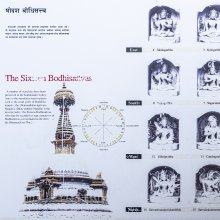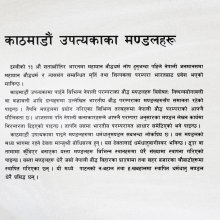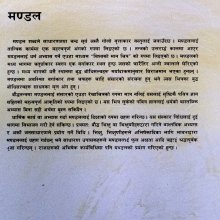Mandal: 5 definitions
Introduction:
Mandal means something in the history of ancient India, Hindi, biology. If you want to know the exact meaning, history, etymology or English translation of this term then check out the descriptions on this page. Add your comment or reference to a book if you want to contribute to this summary article.
Ambiguity: Although Mandal has separate glossary definitions below, it also represents an alternative spelling of the word Mamdala.
Images (photo gallery)
India history and geography
Source: Shodhganga: A translation of Jhaverchand Meghanis non translated folk talesMandal refers to “A group”.—It is defined in the glossary attached to the study dealing with Gujarat Folk tales composed by Gujarati poet Jhaverchand Meghani (1896-1947)

The history of India traces the identification of countries, villages, towns and other regions of India, as well as mythology, zoology, royal dynasties, rulers, tribes, local festivities and traditions and regional languages. Ancient India enjoyed religious freedom and encourages the path of Dharma, a concept common to Buddhism, Hinduism, and Jainism.
Biology (plants and animals)
Source: Wisdom Library: Local Names of Plants and DrugsMandal [ਮੰਦਲ] in the Punjabi language is the name of a plant identified with Eleusine coracana (L.) Gaertn. from the Poaceae (Grass) family having the following synonyms: Cynosurus coracanus, Eleusine africana, Eleusine tocussa. For the possible medicinal usage of mandal, you can check this page for potential sources and references, although be aware that any some or none of the side-effects may not be mentioned here, wether they be harmful or beneficial to health.
Source: Google Books: CRC World Dictionary (Regional names)1) Mandal in India is the name of a plant defined with Eleusine coracana in various botanical sources. This page contains potential references in Ayurveda, modern medicine, and other folk traditions or local practices It has the synonym Cynosurus coracan L. (among others).
2) Mandal is also identified with Erythrina stricta It has the synonym Corallodendron strictum (Roxb.) Kuntze (etc.).
3) Mandal is also identified with Rhododendron arboreum.
Example references for further research on medicinal uses or toxicity (see latin names for full list):
· American Journal of Botany (1984)
· De Fructibus et Seminibus Plantarum… . (1788)
· Journal of Ethnopharmacology (2003)
· Species Plantarum (1753)
· Gartenflora (1872)
· Annalen des Naturhistorischen Museums in Wien (1965)
If you are looking for specific details regarding Mandal, for example diet and recipes, extract dosage, health benefits, pregnancy safety, chemical composition, side effects, have a look at these references.

This sections includes definitions from the five kingdoms of living things: Animals, Plants, Fungi, Protists and Monera. It will include both the official binomial nomenclature (scientific names usually in Latin) as well as regional spellings and variants.
Languages of India and abroad
Hindi dictionary
Source: DDSA: A practical Hindi-English dictionaryMandal in Hindi refers in English to:—(nm) a circle; ring; zone, territory; board; orbit; the path or orbit of a heavenly body; halo; multitude, collection; each of the ten divisions of the Rigved..—mandal (मंडल) is alternatively transliterated as Maṃḍala.
...
Nepali dictionary
Source: unoes: Nepali-English DictionaryMandal is another spelling for मण्डल [maṇḍala].—n. 1. circle; orb; circumference; ring; sphere; 2. zone; district; province; 3. council; union; association; 4. a disc (esp. of the sun/moon); 5. the halo round the sun or moon; 6. a division of the Rig-Veda (the whole collection being divided into 10 Mandalas or eight-Ashtakas);
Nepali is the primary language of the Nepalese people counting almost 20 million native speakers. The country of Nepal is situated in the Himalaya mountain range to the north of India.
See also (Relevant definitions)
Starts with (+150): Mamdaladhipati, Mamdalagati, Mamdalakayi, Mamdalamari, Mamdalamgollu, Mamdalamka, Mamdalaseve, Mamdalia, Mamdalia, Mamdalige, Mamdaligol, Mamdalikka, Mamdalir, Mamdaliru, Mamdalisu, Mandal-acarya, Mandal-adhipati, Mandala, Mandala gadde, Mandala kaayi.
Ends with: Kamandal, Kuhirimandal, Mantrimandal, Murkhmandal, Nirnaayak-mandal, Nirvaachak-mandal, Parimandal, Prabhamandal, Pramandal, Pratimandal, Shikhimandal, Shishtmandal, Shruti-mandal, Vaadya-mandal, Vastu-purusha-mandal.
Full-text: Nirnayaka-mandala, Shrutimandala, Nirvaachak-mandal, Nirnaayak-mandal, Shruti-mandal, Vaadya-mandal, Narayanapura, Suryamandala, Natavadi, Mamdala, Vastu-purusha-mandal, Mandalin, Jalandhara, Kusumapura, Vengi, Mandala.
Relevant text
Search found 25 books and stories containing Mandal; (plurals include: Mandals). You can also click to the full overview containing English textual excerpts. Below are direct links for the most relevant articles:
Modern Marathi Poetry: A Remarkable Decade < [July-August 1931]
Our Forum < [July-August 1932]
New Ways in Marathi Literature < [March-April 1931]
The backdrop of the Srikanthacarita and the Mankhakosa (by Dhrubajit Sarma)
Part 10 - Merits and demerits (of the Śrīkaṇṭhacarita) < [Chapter III - Literary Assessment Of The Śrīkaṇṭhacarita]
Part 2i - Rasa (9): Śānta or the sentiment of tranquility < [Chapter III - Literary Assessment Of The Śrīkaṇṭhacarita]
Part 7 - Works of Maṅkhaka < [Chapter I - Introduction]
Amaravati Art in the Context of Andhra Archaeology (by Sreyashi Ray chowdhuri)
Lower Kṛṣṇā Valley (32): Dantapuram < [Chapter 2 - Amarāvatī and other Archaeological Sites of Ancient Andhra Pradesh]
Lower Kṛṣṇā Valley (14): Vaddamānu < [Chapter 2 - Amarāvatī and other Archaeological Sites of Ancient Andhra Pradesh]
Jainism and Patanjali Yoga (Comparative Study) (by Deepak bagadia)
Part 5 - Jain scriptures and Spiritual teachers < [Chapter 3 - Jain Philosophy and Practice]
Part 10 - Afflictions: Avidya v/s Mithyattva < [Chapter 4 - A Comparative Study]
Trishashti Shalaka Purusha Caritra (by Helen M. Johnson)
Preface to volume 5 < [Prefaces]
Related products





